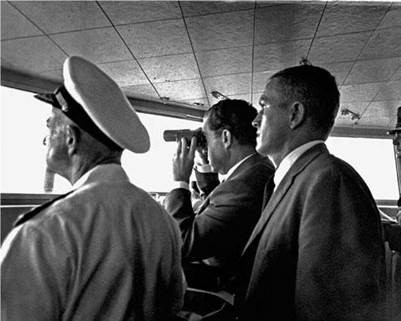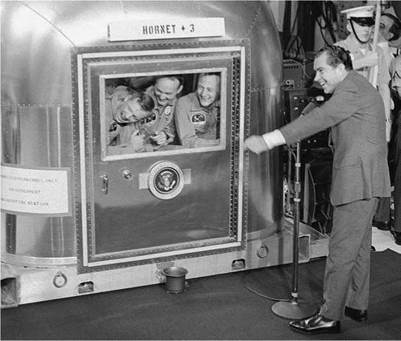NASA and BOB Clash
NASA Administrator Paine in August had told his NASA colleagues to prepare a budget reflecting what became Option I in the STG report; the resulting requests totaled $5.4 billion. Paine’s reaction was that these requests “far exceed the dollar level that can be reasonably expected.” At this point, NASA’s internal budget process was in “disarray,” with “Apollo euphoria” prevalent and Paine and other senior NASA officials concentrating on the STG process.13
In submitting the NASA budget request of $4.5 billion, Paine characterized it as consistent with Option II of the STG report, the choice he had recommended to the president. Paine also reminded Mayo that the official $3.5 billion target had been “issued prior to the Task Group’s report and recommendations.” If that budget level were forced on NASA, said Paine, “major program decisions totally inconsistent with the Task Group’s recommendations” would be needed, including “immediate decisions on terminating manned flight operations.”14 This was the first of several times during the budget review when NASA claimed that there would be drastic consequences with respect to human space flight if its budget was reduced, only to find ways of avoiding those consequences when it was forced to accept a lower budget.
Over the next month, the BOB space budget examiners reviewed the NASA request. They initially thought that NASA was likely to end up with a budget at the $3.7-$3.9 billion level, but they were directed by Robert Mayo in “strong words” to keep the budget at $3.5 billion. Driving Mayo’s action was Richard Nixon’s focus on balancing the budget in the face of continuing inflation and the end of the tax surcharge that had been in place to help pay for the costs of the Vietnam war, even as the conflict continued. The fiscal outlook was much less optimistic in October than it had been only a few months earlier; the president’s policies were not producing the desired results in terms of controlling inflation and stimulating economic growth and increased federal revenues.
To reduce the NASA request by $1 billion, the BOB staff made “meat-axe cuts.” There was no coherent rationale behind these cuts, but even so the staff composed a paper, delivered to NASA on November 13, that attempted to explain the reasoning behind the BOB’s “tentative allowance” of $3.5 billion for FY1971. At this budget level, there would be only one Apollo launch per year. Saturn V production would be “suspended”; production capabilities would be mothballed, to be restarted if additional launch vehicles subsequently were needed. Additional research on space shuttle technologies would be required before detailed design and development of the vehicle would be approved. Space station development was deferred.15
In a strongly worded November 18 letter, Paine told Mayo that “the allowance and rationale are both unacceptable,” since they failed to support “even the minimal requirements of a balanced forward-looking U. S. space program.” He added that “the proposed rationale ignores and runs counter to the conclusions reached by the Space Task Group. . . By refusing to recognize the need for a planning rationale and by undercutting existing commitments, the BOB staff proposals would force the President to reject the space program as an important continuing element of his Administration’s total program.” Paine reiterated his argument that a NASA budget of less than $4 billion/year “would require decisions to suspend manned flights.” He closed his missive by expressing “his disappointment that at this point in the budget process so much effort has been expended and so little accom – plished.”16
Paine and Mayo and their relevant staffs met on November 21 to discuss their differences, but according to one of those present “it was a fairly short meeting and quite—you would not say bitter—but it broke fairly quickly because we couldn’t accommodate anything”; according to another participant, “Paine went away angry.” Paine and Mayo did agree that being so far apart so late in the budget process was not a good situation, and directed their staff members to work together to try to narrow the differences.17
There was some movement over the next few days. NASA developed four new budget alternatives, ranging from $4.4 to $3.9 billion, but Paine insisted that in order to make “meaningful forward progress on the key space station and space shuttle programs without sacrificing key elements of the balanced STG program,” a budget of $4.25 billion was the lowest that he and Mayo should “responsibly recommend to the President.” Paine continued to use the STG report as his basis for the president’s budget decisions; he suggested to Mayo that “your job and my job” was to help Nixon “redirect America’s space efforts into the forward looking course charted by the Space Task Group.” NASA’s consistent strategy, whatever budget level was finally approved, was to keep in the budget some meaningful funding for the station/shuttle combination that was key to post-Apollo human flights. To do this, said Paine, “if we must sacrifice current important programs—like Saturn V production—so be it.”18
At this point in the budget process, normal practice called for the BOB director to meet with the president to make his recommendations on budget level and associated issues and to explain to the president the areas where these recommendations were not accepted by the affected agency. The agency head was not to be present; he would be given a chance to appeal the president’s tentative decisions once they were communicated to him. The Nixon-Mayo meeting took place on the afternoon of December 5. Also present at the meeting was John Ehrlichman and, for the portion of the meeting dealing with NASA, Peter Flanigan.
There was one problem lurking in the background of the meeting—by this time, Richard Nixon had discovered that he “just plain did not like Mayo” and did not relish dealing with the BOB director, whose “mannerisms and odd sense of humor thoroughly alienated the President.” This dislike was shared by Ehrlichman and Flanigan, and colored the relations between Nixon’s White House staff and the BOB through the remainder of the budget deliberations, with the two parties not communicating well and often working at cross purposes. By the time of his meeting with the president, Mayo had increased his recommended FY1971 budget for NASA to $3.7 billion; this figure included launching two Apollo missions a year and continuing Saturn V production.19












